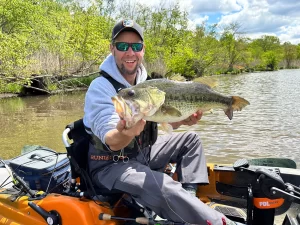For anglers aiming to catch larger bass, targeting waters with a balanced age structure is key. A recent situation at an Illinois fish farm has shed light on the importance of this balance, offering valuable insights for those chasing trophy largemouths.
The Predatory Nature of Largemouth Bass
In the world of fishing, the predatory behavior of fish forms the foundation of the sport. Anglers have long understood that big fish eat smaller fish, a concept that has driven the creation of countless lures and baits designed to mimic prey. However, this natural instinct also plays a crucial role in maintaining a healthy and balanced ecosystem, which is essential for sustaining larger fish populations.
A balanced ecosystem, where there is an appropriate ratio of big fish to smaller fish, is vital for the overall health of a body of water. When large predators like bass are removed, the smaller fish population can explode, leading to overcrowding and stunted growth. Conversely, without enough smaller fish to feed on, the remaining larger bass may struggle to survive.
The Cannibalism Conundrum at Illinois Fish Farms
Recently, an interesting challenge has emerged at an Illinois fish farm, where largemouth bass are being raised for commercial sale. The farm is experiencing significant losses due to a rather unusual problem: cannibalism. The bass, which are being raised in outdoor holding ponds, are devouring each other, leading to a reduction in the overall population and a significant loss in potential profits.
This issue arises because bass do not all grow at the same rate, even when they start as similarly sized fingerlings. In a controlled environment like a tank, this disparity in growth may not be immediately noticeable, but when these fish are moved to larger ponds, the difference becomes apparent. Larger bass, with their natural predatory instincts, begin to prey on their smaller counterparts, leading to cannibalism.
This situation has prompted the involvement of researchers from Southern Illinois University, who are working to develop a strategy for separating the fish based on size. However, until a solution is found, the farm continues to lose fish as the larger bass feast on the smaller ones.

Understanding Stunted Growth in Bass Populations
The phenomenon observed at the Illinois fish farm is not unique to commercial operations. It is a scenario that plays out in natural bodies of water as well, where a lack of predatory fish can lead to stunted growth in bass populations. In such environments, small bass are left unchecked, competing for limited food resources. As a result, they do not reach their full potential size, and the overall quality of fishing in that water body diminishes.
Anglers often encounter this issue in local ponds and lakes, where catching numerous small bass is common, but landing a trophy-sized fish is rare. This stunted growth is often the result of overfishing, where larger, more desirable bass are removed from the ecosystem, leaving behind only the smaller fish.
The Importance of Balance for Trophy Bass Fishing
For anglers seeking to catch larger bass, it is essential to fish in waters where the population is well-balanced. These are often locations where catching a big fish requires more effort and patience, as the competition among predators is higher, and the food supply is sufficient to support their growth.
In some cases, invasive species can inadvertently help restore balance to a stunted fishery. For example, the introduction of northern snakeheads in certain regions has led to a reduction in small bass populations, allowing the remaining bass to grow larger as they face less competition for food. While invasive species are generally viewed as a threat to native ecosystems, their impact on bass populations has shown that balance, even when artificially introduced, can lead to bigger fish.
For those serious about catching larger bass, it’s crucial to focus on waters that offer a balanced ecosystem. This may mean fishing in locations where bites are less frequent, but the reward of landing a trophy-sized bass is far greater. By understanding the dynamics of fish populations and the importance of balance, anglers can increase their chances of success and enjoy more rewarding fishing experiences.
Image/Source: OutdoorLife





